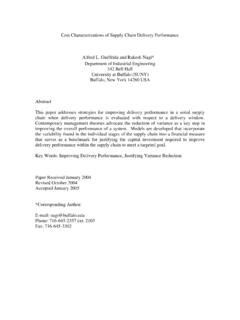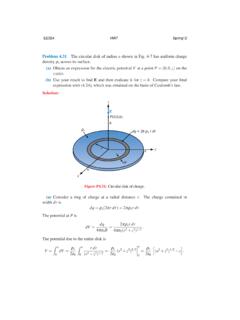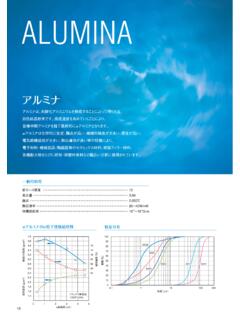Transcription of Problem 2.11 A 50-Ωmicrostrip line uses a 0.6-mm alumina ...
1 Problem 50- microstrip line uses a alumina substrate with r= CD Module to determine the required strip widthw. Include a printout of thescreen :According to the solution provided by CD Module , the required stripwidth isw= lossless transmission line is terminated in a short circuit. Howlong (in wavelengths) should the line be for it to appear as an open circuit at its inputterminals?Solution:From Eq. ( ),Zscin=jZ0tan l. If l= ( /2+n ), thenZscin=j ( ).Hence,l= 2 2+n = 4+n is evident from Figure (d). Problem 75- resistive load is preceded by a /4 section of a 50- losslessline, which itself is preceded by another /4 section of a 100- line. What is theinput impedance? Compare your result with that obtained through two successiveapplications of CD Module :The input impedance of the /4 section of line closest to the load is foundfrom Eq. ( ):Zin=Z20ZL=50275= .The input impedance of the line section closest to the load can be consideredas theload impedance of the next section of the line.
2 By reapplying Eq. ( ), thenextsection of /4 line is taken into account:Zin=Z20ZL= . Problem 100-MHz FM broadcast station uses a 300- transmission linebetween the transmitter and a tower-mounted half-wave dipole antenna. The antennaimpedance is 73 . You are asked to design a quarter-wave transformer to match theantenna to the line.(a)Determine the electrical length and characteristic impedance of the quarter-wave section.(b)If the quarter-wave section is a two-wire line withD= cm, and the wiresare embedded in polystyrene with r= , determine the physical length ofthe quarter-wave section and the radius of the two wire :(a)For a match condition, the input impedance of a load must match that of thetransmission line attached to the generator. A line of electrical length /4 can beused. From Eq. ( ), the impedance of such a line should beZ0= ZinZL= 300 73=148 .(b) 4=up4f=c4 rf=3 1084 100 106= m,and, from Table 2-2,Z0=120 ln Dd +s Dd 2 1.
3 Hence,ln Dd +s Dd 2 1 =148 ,which leads to Dd +s Dd 2 1= ,and whose solution isD/d= Hence,d= 50- lossless line of lengthl= connects a 300-MHzgenerator witheVg=300 V andZg=50 to a loadZL. Determine the time-domaincurrent through the load for:(a)ZL= (50 j50) (b)ZL=50 (c)ZL=0 (short circuit)For (a), verify your results by deducing the information you need from the outputproducts generated by CD Module :VgZinZ0ZL~+-+-Transmission lineGeneratorLoadz = -lz = 0 VgIiZin~Vi~~+- (50-j50) l = = 50 50 ZgFigure :Circuit for Problem (a).(a)ZL= (50 j50) , l=2 = (rad)=135 . =ZL Z0ZL+Z0=50 j50 5050 j50+50= j50100 j50= .Application of Eq. ( ) gives:Zin=Z0 ZL+jZ0tan lZ0+jZLtan l =50 (50 j50) +j50 tan 135 50+j(50 j50)tan 135 = (100+j50) .Using Eq. ( ) givesV+0= eVgZinZg+Zin! 1ej l+ e j l =300(100+j50)50+ (100+j50) 1ej135 + e j135 =150e j135 (V),eIL=V+0Z0(1 ) =150e j135 50(1 ) = (A),iL(t) =Re[eILej t]=Re[ ej6 108t]= cos(6 108t )(A).
4 (b)ZL=50 , =0,Zin=Z0=50 ,V+0=300 5050+50 1ej135 +0 =150e j135 (V),eIL=V+0Z0=15050e j135 =3e j135 (A),iL(t) =Re[3e j135 ej6 108t] =3 cos(6 108t 135 )(A).(c)ZL=0, = 1,Zin=Z0 0+jZ0tan 135 Z0+0 =jZ0tan 135 = j50 ( ),V+0=300( j50)50 j50 1ej135 e j135 =150e j135 (V),eIL=V+0Z0[1 ] =150e j135 50[1+1] =6e j135 (A),iL(t) =6 cos(6 108t 135 )(A).From output of Module , atd=0 (load)eI(d) = rad,which corresponds toeI(d) = .The equivalent time-domain current atf=300 MHz isiL(t) = cos(6 108t )(A). Problem generator witheVg=300 V andZg=50 is connected to a loadZL=75 through a 50- lossless line of lengthl= .(a)ComputeZin, the input impedance of the line at the generator end.(b)ComputeeIiandeVi.(c)Compute the time-average power delivered to the line,Pin=12Re[eVieI i].(d)ComputeeVL,eIL, and the time-average power delivered to the load,PL=12Re[eVLeI L]. How doesPincompare toPL?
5 Explain.(e)Compute the time-average power delivered by the generator,Pg, and the time-average power dissipated inZg. Is conservation of power satisfied?Solution:VgZinZ0~+-+-Transmiss ion lineGeneratorLoadz = -lz = 0 VgIiZgZin~Vi~~+- l = = 50 50 75 Figure :Circuit for Problem (a) l=2 =54 ,Zin=Z0 ZL+jZ0tan lZ0+jZLtan l =50 75+j50 tan 54 50+j75 tan 54 = ( ) .(b)eIi=eVgZg+Zin=30050+ ( )= (A),eVi=eIiZin= ( ) = (V).(c)Pin=12Re[eVieI i] =12Re[ ]= ( ) =216(W).(d) =ZL Z0ZL+Z0=75 5075+50= ,V+0=eVi 1ej l+ e j l = ej54 + j54 =150e j54 (V),eVL=V+0(1+ ) =150e j54 (1+ ) =180e j54 (V),eIL=V+0Z0(1 ) =150e j54 50(1 ) = j54 (A),PL=12Re[eVLeI L] =12Re[180e j54 ] =216 (W).PL=Pin, which is as expected because the line is lossless; power input to the lineends up in the load.(e)Power delivered by generator:Pg=12Re[eVgeIi] =12Re[300 ] =486 cos( ) = (W).
6 Power dissipated in Zg:PZg=12Re[eIieVZg] =12Re[eIieI iZg] =12|eIi|2Zg=12( )2 50= (W).Note 1:Pg=PZg+Pin= the circuit shown in Fig. , calculate the average incidentpower, the average reflected power, and the average power transmittedinto the infinite100- line. The /2 line is lossless and the infinitely long line is slightly lossy. (Hint:The input impedance of an infinitely long line is equal to its characteristic impedanceso long as 6=0.)Z0 = 50 Z1 = 100 /250 2 VPaviPavrPavt8 +Figure :Circuit for Problem :Considering the semi-infinite transmission line as equivalent to a load(since all power sent down the line is lost to the rest of the circuit),ZL=Z1=100 .Since the feed line is /2 in length, Eq. ( ) givesZin=ZL=100 and l= (2 / )( /2) = , soe j l= 1. Hence =ZL Z0ZL+Z0=100 50100+50= , converting the generator to a phasor giveseVg=2ej0 (V). Plugging all theseresults into Eq.
7 ( ),V+0= eVgZinZg+Zin! 1ej l+ e j l = 2 10050+100 "1( 1) +13( 1)#=1ej180 = 1 (V).From Eqs. ( ), ( ), and ( ),Piav= V+0 22Z0=|1ej180 |22 50= mW,Prav= | |2 Piav= 13 2 10 mW= mW,Pav=Ptav=Piav+Prav= mW mW= the Smith chart to find the reflection coefficient correspondingto a load impedance of(a)ZL=3Z0(b)ZL= (2 j2)Z0(c)ZL= j2Z0(d)ZL=0 (short circuit)Solution:Refer to Fig. (a)PointAiszL=3+j0. = (b)PointBiszL=2 j2. = (c)PointCiszL=0 j2. = (d)PointDiszL=0+j0. = OF REFLECTION COEFFICIENT IN DEGREES > WAVELENGTHS TOWARD GENERATOR > < WAVELENGTHS TOWARD LOAD < INDUCTIVE REACTANCE COMPONENT (+jX/Zo), OR CAPACITIVE SUSCEPTANCE (+jB/Yo)CAPACITIVE REACTANCE COMPONENT (-jX/Zo), OR INDUCTIVE SUSCEPTANCE (-jB/Yo)RESISTANCE COMPONENT (R/Zo), OR CONDUCTANCE COMPONENT (G/Yo) ABCDF igure :Solution of Problem Problem using CD Module :Figure (a)Figure (b)Figure (c)Figure (d) Problem the Smith chart to find the normalized load impedancecorresponding to a reflection coefficient of(a) = (b) = 60 (c) = 1(d) = 30 (e) =0(f) = OF REFLECTION COEFFICIENT IN DEGREES > WAVELENGTHS TOWARD GENERATOR > < WAVELENGTHS TOWARD LOAD < INDUCTIVE REACTANCE COMPONENT (+jX/Zo), OR CAPACITIVE SUSCEPTANCE (+jB/Yo)CAPACITIVE REACTANCE COMPONENT (-jX/Zo), OR INDUCTIVE SUSCEPTANCE (-jB/Yo)RESISTANCE COMPONENT (R/Zo), OR CONDUCTANCE COMPONENT (G/Yo) A B C D E F Figure :Solution of Problem :Refer to Fig.
8 (a)PointA is = atzL=3+j0.(b)PointB is = atzL=1+ (c)PointC is = 1 atzL=0+j0.(d)PointD is = j30 atzL= (e)PointE is =0 atzL=1+j0.(f)PointF is =jatzL=0+j1.









